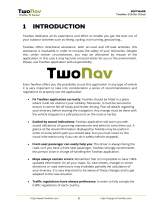
Table of Contents Magellan Triton 1
Table of Contents
Overview .................................................................................................................................1
Features of the Magellan Triton ............................................................................... 1
Specifications ........................................................................................................ 3
Fundamentals ..........................................................................................................................4
Turning the Triton on ......................................................................................... 4
Turning the Triton off ......................................................................................... 4
Setting the display backlight intensity ................................................................. 4
Setting the Time Zone ........................................................................................ 4
Changing Languages .......................................................................................... 5
Sleep Mode (Backlight Timer) ................................................................................. 5
Waking up the Triton from Sleep Mode ................................................................ 5
Setting the Backlight Timer ................................................................................ 5
Automatic Power Off ............................................................................................... 6
Setting the Power Off Timer interval. ................................................................... 6
Menus ................................................................................................................... 6
Accessing the Main Menu ................................................................................... 6
Navigation Screens ................................................................................................. 7
Accessing the Map Screen Contextual Menu ........................................................ 7
Accessing the Speedometer Contextual Menu ....................................................... 7
Data Fields ............................................................................................................ 8
Customizing the Data Field for the Map Screen .................................................... 8
Customizing the Data Field for the Large Data, Compass or Satellite Status Screen .. 8
Selecting Maps ...................................................................................................... 8
Battery Life ........................................................................................................... 9
Navigation Screens ...............................................................................................................11
Selecting Navigation Screens ............................................................................ 11
Turning Navigation Screens On or Off ................................................................ 11
Customizing the Data Fields for the Map Screen ................................................. 12
Customizing the Data Field for the Large Data, Compass or Satellite Status Screen 12
Accessing the Map Screen Contextual Menu ...................................................... 13
Accessing the Compass or Speedometer Screen Contextual Menu ........................ 13
Map Screen ......................................................................................................... 13
Current Location Screen ....................................................................................... 13
Large Data Screen ................................................................................................ 14
Speedometer Screen ............................................................................................ 14
Resetting the Odometer .................................................................................... 14
Resetting the Trip Odometer ............................................................................. 14




















